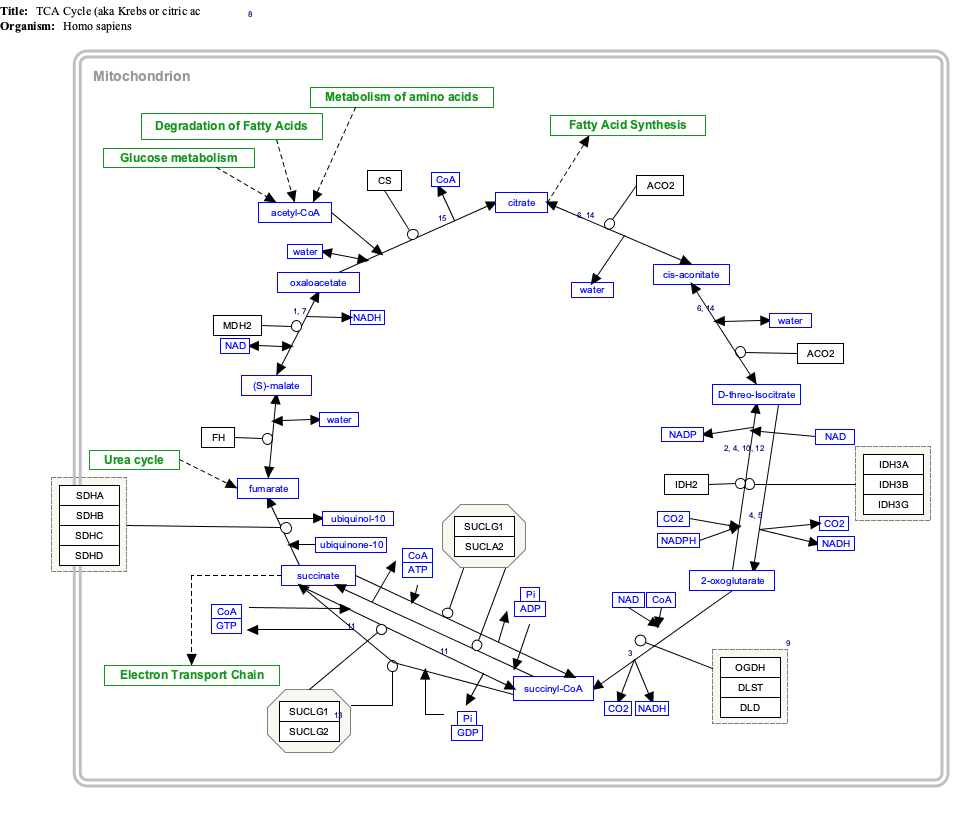m Chembox: remove/replace depecated parameters (via AWB script) |
m replaced the 2D structural diagram of acetyl CoA with one that shows the position of the "acetyl group" (in blue). |
||
| Line 2: | Line 2: | ||
| Watchedfields = changed |
| Watchedfields = changed |
||
| verifiedrevid = 477240040 |
| verifiedrevid = 477240040 |
||
| ImageFile = Acetyl-CoA |
| ImageFile = Acetyl-CoA.jpg |
||
| ImageSize = 320 |
| ImageSize = 320 |
||
| ImageFile2 = Acetyl-CoA-3D-balls.png |
| ImageFile2 = Acetyl-CoA-3D-balls.png |
||
| Line 41: | Line 41: | ||
}} |
}} |
||
}} |
}} |
||
'''Acetyl coenzyme A''' or '''acetyl-CoA''' is an important molecule in [[metabolism]], used in many [[biochemical reaction]]s. Its main function is to convey the [[carbon]] [[atom]]s |
'''Acetyl coenzyme A''' or '''acetyl-CoA''' is an important molecule in [[metabolism]], used in many [[biochemical reaction]]s. Its main function is to convey the two [[carbon]] [[atom]]s of the [[acetyl]] group to the [[citric acid cycle]] ([[Hans Adolf Krebs|Krebs]] cycle) to be [[oxidation|oxidized]] for energy production. Structure of [[coenzyme A]] (CoASH or CoA) consists of a β-mercaptoethylamine group linked to the vitamin [[pantothenic acid]] through an amide linkage. The [[Acetyl|acetyl group]] (indicated in blue in the structural diagram of acetyl-CoA on the top right) is linked by a "high energy" thioester to the sulfhydryl portion of the β-mercaptoethylamine. It is this thioester bond that makes acetyl-CoA one of the "high energy" compounds. Hydrolysis of the thioester bond is highly exergonic (-31.5 kJ). Acetyl-CoA is produced during breakdown of carbohydrates through [[glycolysis]] as well as fatty acid oxidation and enters the [[citric acid cycle]]. |
||
Acetyl-CoA is also an important component in the biogenic synthesis of the neurotransmitter [[acetylcholine]]. [[Choline]], in combination with acetyl-CoA, is catalyzed by the enzyme [[choline acetyltransferase]] to produce acetylcholine and a [[Coenzyme A]] byproduct. |
Acetyl-CoA is also an important component in the biogenic synthesis of the neurotransmitter [[acetylcholine]]. [[Choline]], in combination with acetyl-CoA, is catalyzed by the enzyme [[choline acetyltransferase]] to produce acetylcholine and a [[Coenzyme A]] byproduct. |
||
Revision as of 10:07, 21 February 2016
Acetyl coenzyme A or acetyl-CoA is an important molecule in metabolism, used in many biochemical reactions. Its main function is to convey the two carbon atoms of the acetyl group to the citric acid cycle (Krebs cycle) to be oxidized for energy production. Structure of coenzyme A (CoASH or CoA) consists of a β-mercaptoethylamine group linked to the vitamin pantothenic acid through an amide linkage. The acetyl group (indicated in blue in the structural diagram of acetyl-CoA on the top right) is linked by a "high energy" thioester to the sulfhydryl portion of the β-mercaptoethylamine. It is this thioester bond that makes acetyl-CoA one of the "high energy" compounds. Hydrolysis of the thioester bond is highly exergonic (-31.5 kJ). Acetyl-CoA is produced during breakdown of carbohydrates through glycolysis as well as fatty acid oxidation and enters the citric acid cycle.
Acetyl-CoA is also an important component in the biogenic synthesis of the neurotransmitter acetylcholine. Choline, in combination with acetyl-CoA, is catalyzed by the enzyme choline acetyltransferase to produce acetylcholine and a Coenzyme A byproduct.
Konrad Bloch and Feodor Lynen were awarded the 1964 Nobel Prize in Physiology and Medicine for their discoveries linking acetyl-CoA and fatty acid metabolism. Fritz Lipmann won the Nobel Prize in 1953 for his discovery of the cofactor Coenzyme A.
Functions
Pyruvate dehydrogenase and pyruvate formate lyase reactions
The oxidative conversion of pyruvate into acetyl-CoA is referred to as the pyruvate dehydrogenase reaction. It is catalyzed by the pyruvate dehydrogenase complex. Other conversions between pyruvate and acetyl-CoA are possible. For example, pyruvate formate lyase disproportionates pyruvate into acetyl-CoA and formic acid.
Direct synthesis
The two components of acetyl-CoA—the acetyl, supplied via acetate, and Coenzyme-A groups—can be linked directly, catalyzed by the enzyme acetyl—CoA synthetase. This process is involved in metabolism of carbon sugars. As a starting point for the citric acid cycle, the acetyl—Co-A synthetase route is less common than the pyruvate dehydrogenase route.
Fatty acid metabolism
In animals, acetyl-CoA and other acyl-CoA coenzymes are essential to the balance between carbohydrate metabolism and fat metabolism (see fatty acid synthesis). Under normal circumstances, acetyl-CoA from fatty acid metabolism feeds into the citric acid cycle, contributing to the cell's energy supply. In the liver, when levels of circulating fatty acids are high, the production of acetyl-CoA from fat breakdown exceeds the cellular energy requirements. To make use of the energy available from the excess acetyl-CoA, ketone bodies are produced, which can then circulate in the blood.
In some circumstances, this can lead to the presence of very high levels of ketone bodies in the blood, a condition called ketosis, which is different from ketoacidosis, a dangerous condition that can affect diabetics.
In plants, de novo fatty acid synthesis occurs in the plastids. Many seeds accumulate large reservoirs of seed oils to support germination and early growth of the seedling before it is a net photosynthetic organism. Fatty acids are incorporated into membrane lipids, the major component of most membranes.
Other reactions
- Two acetyl-CoA molecules can be condensed to create acetoacetyl-CoA, the first step in the HMG-CoA reductase/mevalonic acid pathway, leading to synthesis of isoprenoids. In animals, HMG-CoA is a vital precursor to cholesterol and ketone body synthesis.
- Acetyl-CoA is also the source of the acetyl group incorporated onto certain lysine residues of histone and nonhistone proteins in the posttranslational modification acetylation, a reaction catalyzed by acetyltransferases.
- In plants and animals, cytosolic acetyl-CoA is synthesized by ATP citrate lyase.[1] When glucose is abundant in the blood of animals, it is converted via glycolysis in the cytosol to pyruvate, and then to acetyl-CoA in the mitochondrion. The excess of acetyl-CoA results in production of excess citrate, which is exported into the cytosol to give rise to cytosolic acetyl-CoA.
- Acetyl-CoA can be carboxylated in the cytosol by acetyl-CoA carboxylase, giving rise to malonyl-CoA, a substrate required for synthesis of flavonoids and related polyketides, for elongation of fatty acids to produce waxes, cuticle, and seed oils in members of the Brassica family, and for malonation of proteins and other phytochemicals. [2]
- In plants, these include sesquiterpenes, brassinosteroids (hormones), and membrane sterols.
Interactive pathway map
Click on genes, proteins and metabolites below to visit Gene Wiki pages and related Wikipedia articles. The pathway can be downloaded and edited at WikiPathways.
|
TCACycle_WP78 edit
|
Statin pathway edit
|
See also
References
- ^ Fatland, B. L.; Ke, J; Anderson, MD; Mentzen, WI; Cui, LW; Allred, CC; Johnston, JL; Nikolau, BJ; Wurtele, ES (2002). "Molecular Characterization of a Heteromeric ATP-Citrate Lyase That Generates Cytosolic Acetyl-Coenzyme a in Arabidopsis". Plant Physiology. 130 (2): 740–56. doi:10.1104/pp.008110. PMC 166603. PMID 12376641.
- ^ Fatland, B. L. (2005). "Reverse Genetic Characterization of Cytosolic Acetyl-CoA Generation by ATP-Citrate Lyase in Arabidopsis". The Plant Cell Online. 17: 182. doi:10.1105/tpc.104.026211.
External links
- Acetyl+Coenzyme+A at the U.S. National Library of Medicine Medical Subject Headings (MeSH)





















You must be logged in to post a comment.